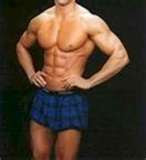
For years I have been advocating the importance and subsequent health benefits of weight training. Athletes as well as your average fitness fanatic have the potential to enhance performance by supplementing their programs with my H.I.G.T training and combining it with a boxing for fitness program. So, why have boxers been reluctant to realize the importance of resistance training? Maybe it's because they will get too big, and slow or lose all of their flexibility. All complete untruths and myth. Let me share a secret with you. Functional muscle will make you faster, hit harder and dominate your sport or life's day to day tasks.
The movements you make are the result of a muscular contraction. Increasing the size of the functional unit of muscle tissue (myofibril hypertrophy) will result in faster more powerful movements. As far as getting big is concerned; this is not a simple or realistic task for anyone not specifically wanting to increase body composition. People that become large from weight training put a great deal of effort in attaining maximum muscle mass. This requires large amounts of food and specific training. This simply does not happen by accident, you can not use the excuse you don't want to get big, you wont! If getting big was as simple as just lifting weights everyone who spent endless hours in the gym would look like bodybuilders. On top of the dedication and hard work proper genetics must also be present to display high levels of muscularity and mass. However genetics alone does not determine your end result.
The proper training program for boxers emphasizes neural training and myofibril hypertrophy. This does not cause significant gains in muscle mass. (Boxers are not bodybuilders; therefore they should not train like bodybuilders). Weight training that involves full range movements has been shown to increase flexibility. Yes , there are people who weight train that are inflexible, but there are also people who have never seen a weight that are inflexible. Incorporate a proper stretching program with your weight training and your flexibility will probably increase. Boxers, don't get to carried away with being flexible. Boxing does not require a great deal of flexibility. Boxing does require adequate flexibility. Excessive flexibility is detrimental to force production.
High reps and light weights are the chosen weight training method for most boxers. This is the complete opposite of what the weight training regimen should look like. High reps and light weight do little to improve absolute strength and speed-strength . This too often used method of weight training is a form of muscular endurance training. Done on occasion this regimen would be fine.
When you hit heavy bags, run, jump rope, etc. you are performing muscular endurance work. When you step in the weight room it's time to switch modes. Boxing is a sport that requires the development of multiple motor qualities. Speed, strength, and endurance are all motor qualities that must be developed in boxers.
As I said earlier traditional boxing training develops muscular endurance, as well as coordination, and skill. The goal in the weight room is to increase absolute strength through the use of heavy weights, and to increase speed-strength by moving moderate to heavy weights at rapid speeds. The top priority in training is to increase absolute strength, speed-strength as well as burn fat and build a lean muscular body... is the stimulation of fast-twitch muscle fibers. This is done through bouts of high intensity weight training. Again I feel my H.I.G.T program is a form of training far superior to other training programs. Keep in mind high rep, light weight work does not recruit fast twitch fibers. Never has never will! This type of training recruits slow twitch and what over time amounts to very little result and overall change in body composition. I hear all the time "I just want to be tone, not big". This is simply the thought process of an in-experienced athlete of client, still the general public as well as fighters are so reluctant to embrace this truth. Mainly do to years of mis-informed trainers feeding them the the wrong information the wrong body science, since an early age.
In close, let me challenge your way of thinking and training. Embrace this type of training to improve your skill at any sport or your general fitness.
Richard













